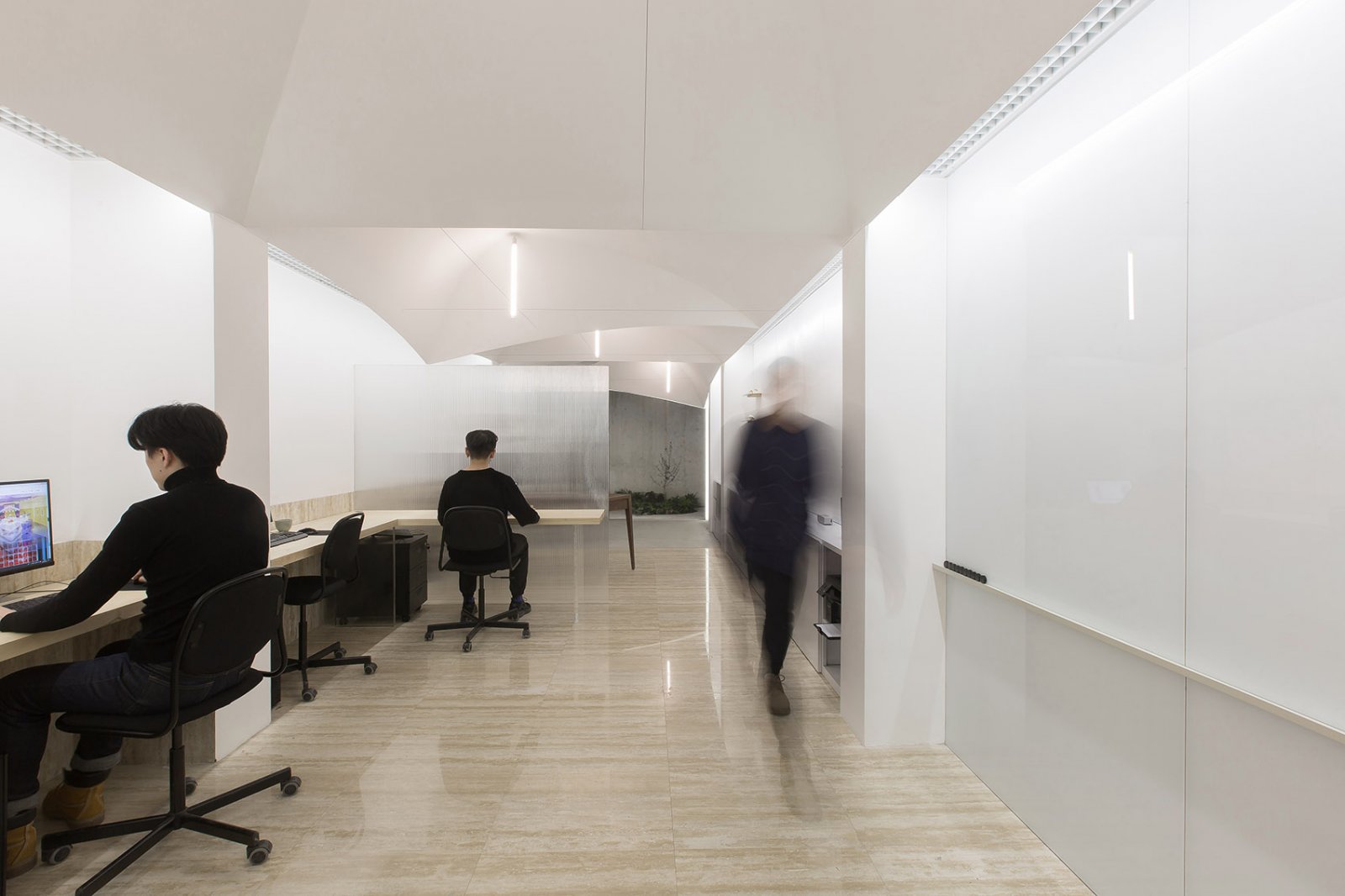Boys Hostel Block Zero Energy Design Lab
2018-08-17 00:00
架构师提供的文本描述。男孩招待所是在现有校园总体规划中作为一个线性建筑群体提出的,这对创造社会活跃和环境可持续空间提出了挑战。
Text description provided by the architects. The boys’ hostel was proposed as a linear built mass in the existing master plan of the campus, which posed challenges to create socially active and environmentally sustainable spaces.
它容纳360名具有娱乐法院和食堂设施的学生。宿舍设有三高台,远离传统宿舍的感觉。它给了他们一个机会,在户外品尝和品尝我们的户外。阶地
It houses 360 students with recreational courts and mess facilities. The dorms are provided with triple height terrace which takes away from the feeling of a conventional dorm. It gives them an opportunity to come out and savour the outdoors. Terraces & activities are layered at multiple levels to boost intercommunication amongst the students. The contorting central atrium allows natural light to penetrate deeper in the building and also acts as a solar chimney that takes away the stale and hot air within the building through stack effect. The building is also cost effective, built at a rate of Rs. 1400/sq.ft without compromising on construction quality.
在设计过程中的关键因素是加强学生之间的互动,在室内空间向外渗透,并与周围的景观互动。线状地块在南面和北面分别有一个遮荫的入口(夏季庭院)和一个开阔的露台(冬季庭院),以鼓励人们在任何时候和季节上进行活动。坡道作为室外和室内寒冷之间的过渡空间,从而保护学生免受热冲击。它还包括一个自助餐厅,作为鼓励和促进社会活动的学生磁石。阴凉的坡道,加上自助餐厅和固定的商店,创造了一个舒适的空间,足以维持学生之间的长时间交谈。楼上的露台使人可以在夏天、晚上和冬季下午享受天气。露台俯瞰竞技场,并与校园绿地和其他建筑物的整体环境建立视觉对话。
The key factor in the design process was to enhance student interaction, within the indoor spaces that percolates outward and interacts with the landscape around it. The linear block was twisted to create, a shaded entrance (summer court) and an open terrace (winter court) on south and north facades respectively, to encourage activities at all times diurnally and seasonally. The ramp acts as a transition space between the harsh outdoor and cooler indoors thus protecting students from getting thermal shock. It also consists of a cafeteria which acts as a student magnet that encourages and promotes social activity. The shaded ramp coupled with the cafeteria and a stationary shop creates a comfortable space which is enough to sustain long conversations amongst the students. The terrace upstairs enables one to enjoy the weather during summer evening and winter afternoons. The terrace overlooks the playing field and establishes a visual dialogue with the overall context of the campus greens and other buildings.
“设计战略”气候敏感性一直是我们过程中的一个重要参数,随后对太阳辐射和空气运动进行分析,以便在外墙上形成第二层皮肤,以便始终保持隔热和透光性。这座建筑的边缘是一块砖墙,为它的外墙增添了独特的特征和质感。利用软件(Ecotect,Grasshop)模拟了每块砖的旋转角度,以尽量减少太阳辐射,并在立面上直接获得热量。砖皮还容纳阳台(4‘宽),充当室内和室外空间之间的缓冲地带,旨在全年保持室内和室外的平均温度。贾利还创造了独特的光线和阴影特征,为学生使用的每一个房间呈现出一个单独的、真正不同的形象。该项目所用的所有当地材料都是在距工地500公里范围内采购的。
Design Strategy Climate sensitivity has been an important parameter in our process, which followed, analysis of solar radiation and air movement to develop a second skin on the façade that allows for thermal insulation and light permeability at all time. A brick jali, circumscribing the building adds a unique character and texture to its façade. The rotation angles of each brick were stimulated using software (Ecotect, Grasshopper) to minimize solar radiations and direct heat gain on the façade. The brick skin also accommodates balconies(4’ wide) which acts as a buffer zone between indoor and outdoor spaces designed to remain at mean temperatures between the inside and outside throughout the year. The jali also created a unique character of light and shadow that renders a separate and a truly different imagery for each of the rooms used by the students. All local materials used for this project and were procured within the radius of 500 km from the site.
施工方法21英尺高,1英寸厚钢筋固定在钢筋混凝土梁使用希尔蒂化学品。砖块是专门制造的单孔,使它们可以堆叠在一起,通过插入一个单一的整体一个单一的钢筋。根据蚱蜢的脚本,砖分别旋转在一个特定的角度,以减少太阳辐射,提供充足的日光和通风的活单位背后的皮肤。没有用水泥砂浆建造这座监狱,其高度为21英尺,长度为250英尺。
Construction Methodology 21 feet high, 1” thick steel bars were fixed on the R.C.C beams using Hilti chemicals. Bricks were specially manufactured with single holes so that they can be stacked one on top of each other by inserting a single piece steel bar through the single whole. Based on the grasshopper script the brick were individually rotated on a specific angle to reduce solar radiation, provide adequate daylight and ventilation to the living units behind the skin. No cement mortar was used to construct the jail spanning 21 feet in height and 250 feet in length.
立面设计策略使用Rhino,Grasshop和Ladybug编写了一个参数化脚本,用于分析主立面上的直接辐射和扩散辐射水平。主立面上每个网格单元的辐射值随后成为其前面砖块旋转角度的输入。通过这样做,直接辐射和扩散辐射在主表面上减少了70%。因此,减少热量增加的原则可居住空间后面的贾利墙。日常照明水平在生活单位也不断检查,以确保贾利不减少超过250勒克斯。
Facade Design Strategy Using Rhino, Grasshopper and Ladybug a parametric script was written to analyse level of direct and diffused radiation on the primary façade. The radiation value of each grid cell on the primary façade then became the input for the rotation angles of the brick in front of it. By doing this, direct and diffused radiations were reduced by 70% on the principle façade. Hence, reducing heat gain on the principle habitable spaces behind the jali wall. Day lighting levels in the living units were also constantly checked to ensure that the jali does not reduce it beyond 250 lux.
Architects Zero Energy Design Lab
Location Gurugram, Haryana, India
Lead Architects Sachin Rastogi, Payal Seth Rastogi
Design Team Rohan Mishra, Naveen Pahal, Arya Kaushik, Tanya Makker
Photographs Andre J. Fanthome
 举报
举报
别默默的看了,快登录帮我评论一下吧!:)
注册
登录
更多评论
相关文章
-

描边风设计中,最容易犯的8种问题分析
2018年走过了四分之一,LOGO设计趋势也清晰了LOGO设计
-

描边风设计中,最容易犯的8种问题分析
2018年走过了四分之一,LOGO设计趋势也清晰了LOGO设计
-

描边风设计中,最容易犯的8种问题分析
2018年走过了四分之一,LOGO设计趋势也清晰了LOGO设计












































































